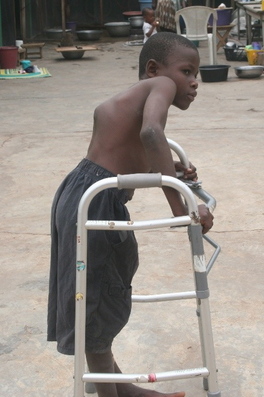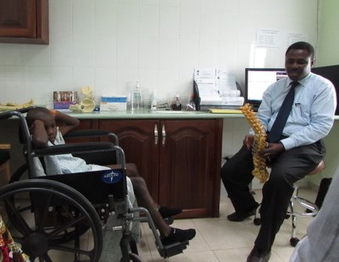Senyo's Story

Senyo and his two older brothers were trafficked to two fishermen to work on Lake Volta. Senyo's father was deceased and his mentally ill mother was unable to care for them. His maternal grandmother was taking care of Senyo, his siblings and cousin. They lived in Adafianu, in the Volta region, near the beach in a coconut palm shack, which provided inadequate shelter, especially when it rained. Because of her impoverished condition, the grandmother struggled to survive so she gave Senyo to a fisherman and his two brothers to another. The fishermen promised they would care for the boys and enroll them in school and they could help them fish on Lake Volta. Senyo was about 12 years old when he was rescued in 2014, although he appeared younger due to malnutrition and his physical disability.
Senyo and his brothers were healthy when they were trafficked to work on Hanikpo, an island on Lake Volta near Kpando-Torkor. They worked long hours bailing water from fishing boats (canoes), mending nets and diving into the water to disentangle nets that were caught on submerged tree trunks.
Senyo and his brothers were healthy when they were trafficked to work on Hanikpo, an island on Lake Volta near Kpando-Torkor. They worked long hours bailing water from fishing boats (canoes), mending nets and diving into the water to disentangle nets that were caught on submerged tree trunks.
The canoe on which children work is often slippery because spirogyra, a freshwater algae, covers the wood's surface. One day, Senyo slipped and fell, hitting his chest against the canoe seat, fracturing several bones in his chest and back.

The severe injury led to Senyo’s complete incontinence and inability to walk unassisted. He experienced excruciating pain, but was never taken to a hospital for treatment. Instead, Senyo’s master and wife used hot compresses on his injury, but to no avail. According to Senyo, he was still forced to work on the lake. His master later took him to see an herbalist for treatment and he left him with this stranger. Two years dragged by as Senyo remained with the herbalist and was further traumatized. He was starved, beaten and forced to crawl to the herbalist’s farm to sweep the large compound. When he soiled himself, he was beaten and forced to clean up. And unbelievably, the herbalist forced him to dance to music.
Fortunately, the intervention of a concerned neighbor led the Department of Social Welfare and Eric Peasah of RTBF/Africa to rescue Senyo. RTBF took him to the FOCOS Orthopedic Hospital in Accra for evaluation. After a series of tests, Dr. Amatefe Mawuli Kwami diagnosed Senyo with five crushed vertebrae (T6-T10), which were compressing his spinal cord. Funds were raised for his life saving spine reconstruction surgery in 2015.
Senyo’s traumatic childhood left deep psychological and physical scars but we have been providing him the care he needs to overcome his feelings of abandonment and distrust of others. After his surgery, he went to live at the Orthopedic Training Center in Nsawam, Ghana. Senyo wants to become a police officer so he can arrest his former master and others that traffick children.
Fortunately, the intervention of a concerned neighbor led the Department of Social Welfare and Eric Peasah of RTBF/Africa to rescue Senyo. RTBF took him to the FOCOS Orthopedic Hospital in Accra for evaluation. After a series of tests, Dr. Amatefe Mawuli Kwami diagnosed Senyo with five crushed vertebrae (T6-T10), which were compressing his spinal cord. Funds were raised for his life saving spine reconstruction surgery in 2015.
Senyo’s traumatic childhood left deep psychological and physical scars but we have been providing him the care he needs to overcome his feelings of abandonment and distrust of others. After his surgery, he went to live at the Orthopedic Training Center in Nsawam, Ghana. Senyo wants to become a police officer so he can arrest his former master and others that traffick children.

Since Senyo has grown, the metal rods supporting his spine were too short. Therefore, he needed one more surgery, costing $10,000, to replace the metal rods.
For more information, visit the Save Senyo page, read newsletters with updates on his journey and view a video of Senyo.
For more information, visit the Save Senyo page, read newsletters with updates on his journey and view a video of Senyo.
